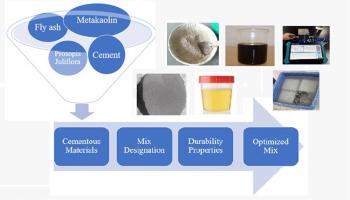Investigation of concrete durability enhancement using supplementary cementitious materials
IF 1.9
Q2 MULTIDISCIPLINARY SCIENCES
引用次数: 0
Abstract
This study investigates the influence of fly ash, metakaolin, and P. juliflora extract on the durability and performance of concrete. The research focuses on key durability tests, including Saturated Water Absorption, RCPT, Sulphuric Acid Resistance, Permeability, Sorptivity, and UPV tests. The experimental results indicate that incorporating fly ash and metakaolin significantly reduces water absorption, permeability, and chloride ion penetration, leading to improved resistance against corrosion and environmental deterioration. The results from the Sulphuric Acid Resistance Test showed that mixes containing metakaolin and fly ash exhibited lower weight and strength loss, demonstrating enhanced acid resistance. The Permeability and Sorptivity Tests further confirmed that blended cementitious materials contribute to a denser microstructure, reducing water ingress. Further, the UPV test suggested that long-term structural integrity improves with supplementary cementitious materials. The optimal combination of 10–15 % fly ash and 10–15 % metakaolin exhibited superior performance. This study concludes that utilizing industrial by-products and natural plant extracts enhances durability, sustainability, and eco-friendliness, making it a viable alternatives for virgin materials.
• Evaluates fly ash, metakaolin, and P. juliflora extract for improving concrete durability.
• Shows reduced chloride penetration, acid damage, and water absorption.
• Confirms denser microstructure and better integrity via UPV and permeability tests.

补充胶凝材料增强混凝土耐久性的研究
研究了粉煤灰、偏高岭土和黄花草提取物对混凝土耐久性和性能的影响。研究重点是关键的耐久性测试,包括饱和吸水率、RCPT、耐硫酸、渗透性、吸附性和UPV测试。试验结果表明,掺加粉煤灰和偏高岭土显著降低了混凝土的吸水率、透气性和氯离子渗透性,提高了混凝土的抗腐蚀能力和环境恶化能力。耐酸试验结果表明,掺偏高岭土和粉煤灰的混合料具有较低的重量和强度损失,具有较好的耐酸性能。渗透性和吸附性测试进一步证实,混合胶凝材料有助于致密的微观结构,减少水的侵入。此外,UPV测试表明,补充胶凝材料可以改善长期结构完整性。10 - 15%粉煤灰和10 - 15%偏高岭土的最佳组合表现出优异的性能。这项研究的结论是,利用工业副产品和天然植物提取物提高了耐久性、可持续性和生态友好性,使其成为原始材料的可行替代品。•评估粉煤灰,偏高岭土,和P. juliflora提取物提高混凝土耐久性。•显示氯渗透,酸损伤和吸水率降低。•通过UPV和渗透性测试确认更致密的微观结构和更好的完整性。
本文章由计算机程序翻译,如有差异,请以英文原文为准。
求助全文
约1分钟内获得全文
求助全文
来源期刊

MethodsX
Health Professions-Medical Laboratory Technology
CiteScore
3.60
自引率
5.30%
发文量
314
审稿时长
7 weeks
期刊介绍:
 求助内容:
求助内容: 应助结果提醒方式:
应助结果提醒方式:


